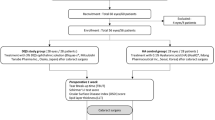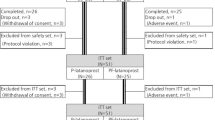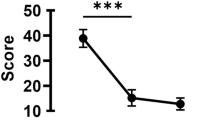Abstract
The use of punctal plugs in the treatment of keratoconjunctivitis sicca (KCS) in inflammatory eye disease remains controversial because of the potentially increased retention time of tears enriched with inflammatory cytokines that may aggravate eye inflammation. We describe the safety and efficacy of punctal occlusion in a retrospective analysis of 19 patients (16 men) with KCS due to chronic GvHD (cGvHD). Efficacy and safety were assessed by subjective and objective criteria (symptoms, corneal fluorescein staining, tear film break-up time (BUT), Schirmer I test, Jones test and visual acuity). Follow-up was from plug insertion until maximum one year after punctal occlusion. After punctal occlusion, patients reported a significant increase in subjective comfort (1.10 vs 0.59 on a scale ranging from no symptoms (0) to severe impairment (2), P<0.001). Pathological corneal fluorescein staining decreased significantly (P<0.001) and tear film BUT remained unchanged (5.98 vs 4.0 s, P=0.79). Measurement of tear secretion or retention time showed a non-significant trend for improvement in the Schirmer I (3.0 vs 3.40 mm, P=0.08) and Jones (1.36 vs 2.8 mm, P=0.08) tests. The logMAR visual acuity remained unchanged. Punctal occlusion achieved a significant improvement in subjective symptoms and objective findings in ocular GvHD without increasing ocular inflammation.
This is a preview of subscription content, access via your institution
Access options
Subscribe to this journal
Receive 12 print issues and online access
$259.00 per year
only $21.58 per issue
Buy this article
- Purchase on Springer Link
- Instant access to full article PDF
Prices may be subject to local taxes which are calculated during checkout



Similar content being viewed by others
References
Filipovich AH, Weisdorf D, Pavletic S, Socie G, Wingard JR, Lee SJ et al. National Institutes of Health consensus development project on criteria for clinical trials in chronic graft-versus-host disease: I. Diagnosis and staging working group report. Biol Blood Marrow Transplant 2005; 11: 945–956.
Ogawa Y, Kuwana M . Dry eye as a major complication associated with chronic graft-versus-host disease after hematopoietic stem cell transplantation. Cornea 2003; 22: 19–27.
Behrens A, Doyle JJ, Stern L, Chuck RS, McDonnell PJ, Azar DT et al. Dysfunctional tear syndrome: a Delphi approach to treatment recommendations. Cornea 2006; 25: 900–907.
Fawzi AA, Cunningham Jr ET . Central serous chorioretinopathy after bone marrow transplantation. Am J Ophthalmol 2001; 131: 804–805.
Kim SK . Update on ocular graft versus host disease. Curr Opin Ophthalmol 2006; 17: 344–348.
Kim RY, Anderiini P, Naderi AA, Rivera P, Ahmadi MA, Esmaeli B . Scleritis as the initial clinical manifestation of graft-versus-host disease after allogenic bone marrow transplantation. Am J Ophthalmol 2002; 133: 843–845.
Couriel D, Carpenter PA, Cutler C, Bolaños-Meade J, Treister NS, Gea-Banacloche J et al. Ancillary therapy and supportive care of chronic graft-versus-host disease: national institutes of health consensus development project on criteria for clinical trials in chronic graft-versus-host disease: v. ancillary therapy and supportive care working group report. Biol Blood Marrow Transplant 2006; 12: 375–396.
Riemens A, te Boome L, Imhof S, Kuball J, Rothova A . Current insights into ocular graft-versus-host disease. Curr Opin Ophthalmol 2010; 21: 485–494.
Sakamoto A, Kitagawa K, Tatami A . Efficacy and retention rate of two types of silicone punctal plugs in patients with and without Sjogren syndrome. Cornea 2004; 23: 249–254.
Tai MC, Cosar CB, Cohen EJ, Rapuano CJ, Laibson PR . The clinical efficacy of silicone punctal plug therapy. Cornea 2002; 21: 135–139.
Murube J, Murube E . Treatment of dry eye by blocking the lacrimal canaliculi. Surv Ophthalmol 1996; 40: 463–480.
Levenson JE, Hofbaver J . Problems with punctal plugs. Arch Ophthalmol 1989; 107: 493–494.
Pflugfelder SC . Antiinflammatory therapy for dry eye. Am J Ophthalmol 2004; 137: 337–342.
Ogawa Y, Okamoto S, Mori T, Yamada M, Mashima Y, Watanabe R et al. Autologous serum eye drops for the treatment of severe dry eye in patients with chronic graft-versus-host disease. Bone Marrow Transplant 2003; 31: 579–583.
Mansour K, Leonhardt CJ, Kalk WW, Bootsma H, Bruin KJ, Blanksma LJ . Lacrimal punctum occlusion in the treatment of severe keratoconjunctivitis sicca caused by Sjögren syndrome: a uniocular evaluation. Cornea 2007; 26: 147–150.
Gencoglu EA, Dursun D, Akova YA, Cengiz F, Yalcin H, Koyuncu A . Tear clearance measurements in patients with dry eye syndrome using qualitative lacrimal scintigraphy. Ann Nucl Med 2005; 19: 581–587.
Robinson MR, Lee SS, Rubin BI, Wayne AS, Pavletic SZ, Bishop MR et al. Topical corticosteroid therapy for cicatricial conjunctivitis associated with chronic graft-versus-host disease. Bone marrow transplantation 2004; 33: 1031–1035.
Marsh P, Pflugfelder SC . Topical nonpreserved methylprednisolone therapy for keratoconjunctivitis sicca in Sjogren syndrome. Ophthalmology 1999; 106: 811–816.
Wang Y, Ogawa Y, Dogru M, Kawai M, Tatematsu Y, Uchino M et al. Ocular surface and tear functions after topical cyclosporine treatment in dry eye patients with chronic graft-versus-host disease. Bone marrow transplantation 2007; 41: 293–302.
Hemady R, Tauber J, Foster SC . Immunosuppressive drugs in immune and inflammatory ocular disease. Surv Ophthalmol 1991; 35: 369–385.
Yen MT, Monroy D, Pflugfelder SC . Punctal occlusion decreases tear production, clearance and ocular surface Sensation. Invest Ophthalmol Vis Sci 1999; 40: S980.
Author information
Authors and Affiliations
Corresponding author
Ethics declarations
Competing interests
The authors declare no conflict of interest.
Rights and permissions
About this article
Cite this article
Sabti, S., Halter, J., Braun Fränkl, B. et al. Punctal occlusion is safe and efficient for the treatment of keratoconjunctivitis sicca in patients with ocular GvHD. Bone Marrow Transplant 47, 981–984 (2012). https://doi.org/10.1038/bmt.2011.205
Received:
Revised:
Accepted:
Published:
Issue Date:
DOI: https://doi.org/10.1038/bmt.2011.205
Keywords
This article is cited by
-
The ocular graft-versus-host disease: the path from current knowledge to future managements
Eye (2023)
-
Okuläre Graft-Versus-Host Erkrankung
Die Ophthalmologie (2023)
-
The disposable bandage soft contact lenses therapy and anterior segment optical coherence tomography for management of ocular graft-versus-host disease
BMC Ophthalmology (2021)
-
Ocular surface system alterations in ocular graft-versus-host disease: all the pieces of the complex puzzle
Graefe's Archive for Clinical and Experimental Ophthalmology (2019)
-
Ocular graft-versus-host disease after hematopoietic cell transplantation: Expert review from the Late Effects and Quality of Life Working Committee of the CIBMTR and Transplant Complications Working Party of the EBMT
Bone Marrow Transplantation (2019)



